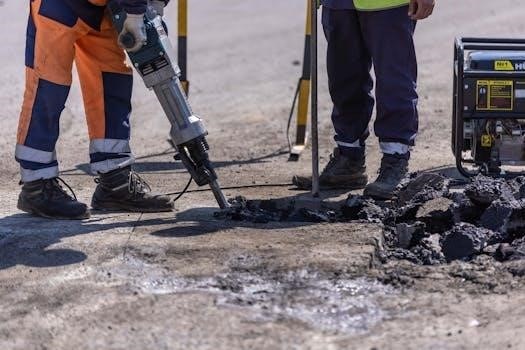Generator manuals are indispensable resources for understanding the intricacies of your equipment․ These guides offer critical information on operation‚ maintenance‚ and troubleshooting․ They are crucial for both novice users and experienced technicians‚ ensuring safe and efficient generator performance․
Importance of Generator Manuals
Generator manuals are vital for ensuring the safe and effective operation of your equipment․ They provide essential guidelines on proper usage‚ maintenance schedules‚ and troubleshooting procedures‚ which helps prevent damage․ They also offer critical information regarding specific generator models‚ including technical specifications‚ safety precautions‚ and recommended maintenance intervals․ Regular consultation of the manual can help users understand the generator’s limitations and prevent misuse‚ extending its lifespan․ The manuals are also essential for diagnosing issues‚ guiding users through steps to identify problems and implement solutions․ Furthermore‚ they often include diagrams and schematics‚ assisting in understanding the generator’s internal workings․ In summary‚ generator manuals are a crucial reference‚ promoting longevity and optimal performance through informed operation and maintenance practices․ Ignoring them can lead to costly repairs or even dangerous situations․

Common Generator Problems
Generators‚ despite their reliability‚ can experience various issues․ These range from start-up failures and power inconsistencies to unusual noises and overheating․ Understanding these problems is key for effective troubleshooting․
Generator Won’t Start Issues
A generator’s failure to start can stem from several factors‚ often related to fuel‚ oil‚ or ignition․ Begin by ensuring the fuel tank has an adequate supply of clean fuel and that the fuel valve is open․ Low oil levels can trigger safety mechanisms‚ preventing ignition; thus‚ check the oil level and replenish if necessary․ Inspect the start switch and choke valve for proper functionality․ Additionally‚ a faulty spark plug‚ could be the culprit‚ or there may be buildup in the carburetor․ Battery issues‚ especially if the generator uses electric start‚ can also impede starting․ If these basic checks don’t resolve the issue‚ delve into more complex possibilities‚ such as fuel pump problems or a malfunctioning automatic voltage regulator‚ which can prevent the engine from initiating․ Also‚ the AC switch‚ while not for starting‚ should be in the correct position․ Regular maintenance can help prevent these issues from occurring in the first place․
Generator Starts Then Dies
When a generator starts but then abruptly shuts down‚ it often indicates an issue with the fuel supply or engine operation․ A common cause is inconsistent fuel flow‚ potentially from a clogged fuel filter or low-quality fuel․ This can cause the engine to falter and stop shortly after starting․ Another potential issue is related to the fuel pump‚ which may be failing to deliver fuel at a consistent rate‚ causing the generator to die․ Also‚ check for proper ventilation‚ as a hermetically sealed unit with insufficient air circulation might cause the engine to stall due to overheating․ Oil pressure problems can also lead to this issue‚ as the system will shut down the generator to prevent damage․ Similarly‚ a faulty automatic voltage regulator could cause the engine to cut out․ Inspect the fuel lines for any kinks or blockages that might impede fuel delivery․ Regular maintenance‚ including fuel filter replacement‚ can prevent this issue․
Power Output Problems

Power output issues in generators can manifest as inconsistent voltage or a complete lack of electricity․ A common culprit is the loss of residual magnetism within the generator‚ which is crucial for initiating power generation․ Additionally‚ a failed automatic voltage regulator (AVR) can lead to unstable or no power output‚ as this component is responsible for maintaining a consistent voltage level․ Check circuit breakers‚ as they might have tripped due to an overload‚ cutting off the power supply․ Faulty outlets or wiring can also prevent power from reaching connected devices․ Overloading the generator beyond its rated capacity can cause it to struggle and produce insufficient power․ Furthermore‚ inspect the capacitor‚ as a damaged capacitor can reduce the efficiency of power generation․ It’s important to test the outlets using a multimeter to ensure they are providing the expected voltage and to check the condition of the electrical connections‚ looking for any signs of corrosion or damage․
Overheating and Cooling Problems
Overheating is a significant concern for generators‚ potentially leading to severe damage․ Low coolant levels are a primary cause‚ as coolant is vital for absorbing and dissipating engine heat․ Similarly‚ insufficient coolant temperature can prevent proper cooling‚ leading to overheating․ The coolant system should also be inspected for clogs or leaks‚ which can impair its efficiency․ If the generator has controls that need to be set to auto‚ verify that they are․ In addition to coolant-related issues‚ a high fuel level can sometimes contribute to overheating․ Ensure that the generator’s air vents are clear‚ allowing for proper airflow and heat exchange․ Coolant replacement is often a necessary step to ensure efficient cooling․ It is also essential to check the generator’s fan and radiator for any obstructions or damage that might affect the cooling process․ Regular checks of the coolant system can prevent many overheating issues and ensure the generator operates within safe temperature ranges․
Unusual Noise Issues
Unusual noises from a generator often indicate underlying problems that need immediate attention․ These noises can range from loud rattling to strange grinding sounds‚ signaling mechanical or operational issues․ Identifying the source of the noise is crucial for effective troubleshooting․ Start by checking for loose components or parts that may have become dislodged during operation․ The generator’s cover and air-vent hose should be securely mounted‚ as these can sometimes cause vibrations and noise; Also‚ inspect the engine’s internal parts for wear or damage‚ which can produce unusual sounds․ Pay attention to any changes in the noise pattern‚ as this can help pinpoint the problem’s location․ It is important to note that some generators‚ like soundproof models‚ are designed to operate quietly․ Any deviation from this normal noise level is a sign that something may be wrong․ Regular maintenance and prompt attention to unusual sounds can prevent further damage and ensure the generator operates smoothly․

Troubleshooting and Solutions
Effective troubleshooting involves systematic checks of fuel‚ oil‚ and electrical components․ Solutions range from simple fixes like fuel top-ups to complex repairs of damaged parts․ This section offers guidance for addressing common generator problems․
Fuel System Checks
When troubleshooting generator issues‚ the fuel system is a crucial area to inspect․ Begin by ensuring that the fuel tank is adequately filled with the correct type of fuel‚ as specified in your generator’s manual․ Check the fuel gauge for accuracy; sometimes‚ a faulty gauge can give a misleading reading․ Examine the fuel lines for any signs of leaks‚ kinks‚ or blockages that could restrict fuel flow to the engine․ Inspect the fuel filter for clogs or debris‚ replacing it if necessary‚ as a dirty filter can impede performance․ For diesel generators‚ ensure the fuel pump is functioning correctly‚ addressing any stalling or intermittent operation issues․ Additionally‚ the quality of fuel can impact performance; therefore‚ use clean‚ high-quality fuel․ If the generator experiences inconsistent fuel flow‚ investigate the fuel pump and fuel filters‚ looking for any obstructions or damage․ Addressing these fuel-related aspects can often resolve starting problems and ensure smooth generator operation․
Oil and Lubrication Issues
Proper lubrication is vital for the smooth operation of any generator․ When troubleshooting‚ start by checking the oil level using the dipstick; insufficient oil can lead to significant problems․ Ensure that the oil is of the correct type and viscosity as recommended in your generator’s manual․ Look for any signs of oil leaks around the engine‚ as these should be addressed immediately․ Regular oil changes are crucial for maintaining optimal performance and preventing engine damage․ Examine the lubrication system components for any blockages or issues that could disrupt oil flow․ Low oil pressure can cause damage‚ so monitor the pressure readings if your generator has a gauge․ Additionally‚ ensure that all lubrication points‚ including bearings and other moving parts‚ are receiving adequate lubrication․ Insufficient lubrication can lead to increased friction‚ overheating‚ and premature wear․ Regular maintenance of the oil system helps prevent common issues like engine stalling‚ excessive noise‚ and premature component failure․ Always adhere to the manufacturer’s recommendations for oil type and change intervals to ensure the longevity of your generator․
Electrical Component Inspection
Inspecting electrical components is a crucial step in generator troubleshooting․ Begin by checking the circuit breakers for any signs of tripping‚ which could indicate an overload․ Examine the voltage regulator‚ as a faulty one can lead to inconsistent power output or a complete lack of power․ Test the outlets using a voltmeter to ensure they are delivering the correct voltage․ Look for loose or corroded wiring connections which can disrupt the flow of electricity․ Check the condition of the spark plugs‚ as damaged or fouled plugs can prevent the generator from starting or cause misfires․ Additionally‚ inspect the automatic voltage regulator (AVR) for any signs of damage or malfunction․ Make sure that the generator’s automatic battery charger is working correctly by running the generator and checking if the battery is charging․ Also‚ check the AC switch‚ ensuring it is functioning properly․ Ensure that all electrical connections are tight and properly insulated to prevent short circuits․ If any components appear damaged or worn‚ they should be replaced immediately to ensure safe and efficient operation․

Maintenance Tips
Regular maintenance is vital for extending the lifespan of your generator․ This includes consistent oil changes‚ checking fuel levels‚ and inspecting electrical components․ Proper upkeep ensures reliable performance and prevents costly repairs․
Regular Operation Practices
Consistent and correct operational practices are crucial for maintaining the health and longevity of your generator․ Start by adhering strictly to the manufacturer’s guidelines outlined in your manual; this includes understanding the recommended load capacity to prevent overloading․ Always ensure that the generator is placed on a level and stable surface‚ in a well-ventilated area‚ away from combustible materials․ Before each use‚ perform a quick visual inspection‚ checking for any leaks or loose connections․ Regularly running the generator‚ even for short periods‚ helps keep the internal components lubricated and prevents issues related to inactivity․ Pay close attention to the fuel type and quality‚ ensuring that it meets the specifications‚ and avoid storing fuel in the generator for extended durations․ Also‚ keep a logbook of your generator’s operation‚ recording hours of use‚ any issues encountered‚ and maintenance performed․ This log will be invaluable for tracking its performance over time and anticipating future maintenance needs․ Lastly‚ always remember to turn off the generator and allow it to cool before performing any maintenance or adding fuel․